QuestionQUESTION: My tropical fish tank holds 11 1/4 gallons of water. It was overcrowded. I cleaned out the whole tank last year in November and used cycle to cycle it.
I did partial water changes a total of 11 times in December, 13 in January, and six times in Feb. Usually I siphoned out 25% of the water. A few times I either siphoned out or just took out a gallon of water in Dec.
I started getting rid of fish in Jan. and am continuing to do so. On Jan. 25, I had a total of 8 3/4 inches of fish. Two babies were found, and the ones that were already there grew. Now I have eleven fish with a total length of nine inches.
I have fancy guppies, some adults and some babies, and an adult neon tetra. I want to know if there is any way to find out if it's okay to siphon out 25% of the water every two weeks now. Thanks.
ANSWER: Hi Dipan,
Siphoning out water would be fine, you could even do it weekly now. Remember that the water doesn't hold the bacteria - the filter media holds most of it. Sure, there is some in gravel, plants, and decorations, but the majority is in the filter. So as long as you make sure you leave some part of the filter intact - the biological media, which only gets rinsed when it's dirty, never replaced - you should be fine. Usually the bio media is something like ceramic rings, foam, a steel wool type of fiber, or a bio-wheel. Leave this alone until it gets dirty; then rinse it with aquarium water.
Remember that neon tetras are schooling fish, so they only feel comfortable and act naturally when there are others of their kind - and not just a few either, but more like 6 or more.
I wouldn't put much stock into the inches of fish rule, since it is only a very rough guideline. For example, 10 neon tetras and one 10 inch oscar are still 10 inches worth of fish lengthwise. What's not being taken into account is the depth of the fish. Guppies are very active so I recommend 24" tanks for them, but they don't create much biological load - except when they start breeding. You have to find a way to sell, trade, or give away the excess juveniles before the tank becomes too crowded with grown out fry. Either that or put them in another tank, preferably one at least the same size if not a bit bigger - and raise them to maturity. Adult guppies will sell better than very young juveniles because their colors will be brighter, and they'll be hardier by then.
I hope that helps, take care!
Nicole
---------- FOLLOW-UP ----------
QUESTION: I don't know if you knew what I meant. I was trying to find out after the over crowding of fish, how to tell if the water is clean enough to clean out a normal amount of times. I had too many fish before, so I was cleaning it out a lot more times than normal when I had them. Will the water tests that test for nitrate, nitrite and ammonia show this? If so which one will show if the water quality is good enough for this?
If this makes a difference, I have a Tetra Internal Whisper Power Filter for 10-30 gallon tanks. From what I told you do you think I should clean my tank every week or can I do it less often like two weeks or whatever? Thanks.
AnswerHi Dipan,
Most experts recommend changing the water weekly, about 20-25% of the volume. Some people prefer to do more less often, like 40% every two weeks. I would really recommend you change some water weekly, anywhere from 20-40%, since you are raising fry (baby guppies). They grow best when the water is fresh - and since they need to eat frequently, tanks where there are fry need more maintenance. If you were moving the fry to another tank, you could change water twice a month with adult fish only.
Ammonia and nitrite should be 0 ppm in an established aquarium at all times, so before you do your water change, test your water to make sure this is the case. If it is not always 0 ppm, that means something is off and you need to figure out what it is. Does your filter not have enough biological media? Do you need to add an extra filter, like a small sponge filter or internal filter? Do you need to be more careful with feeding or feed lower protein foods? (Meaty foods high in protein, like shrimp pellets, are more likely to cause ammonia and nitrite spikes than foods that are vegetable based and lower in protein, like Spirulina flake.)
Nitrate should be 20 ppm or less - if you have nitrate in your tap water, then under 40-50 ppm is a more realistic goal.
As long as your filter is keeping the water quality in check, then it should be fine. I don't know if this is the sort of filter with throw away "cartridges" but one thing I don't like about these sorts of filters is that #1 they are wasteful, and #2 you throw away lots of beneficial bacteria when you change them out. I prefer power filters like the AquaClear filters. The filter itself is like any other, but the media is what I find superior. Instead of a plastic grid with carbon and some floss which you have to throw away once a month or so, you get ceramic rings (Biomax) and foam sponges which can be rinsed in aquarium water or dechlorinated tap water, and reused. This way the beneficial bacteria is kept and you don't have to buy anything new.
So, the short answer to your questions are:
1) Test your water right before you do your water change. Make sure that ammonia and nitrite are 0 ppm, this should always be the case. If nitrates are higher than 20 ppm, you should strive to get them lower, but if your tap water already has nitrate in it then 40-50 ppm is an acceptable range. (Keep in mind that the use of live plants will reduce nitrate naturally.)
2) You can change water twice a month, but there is no doubt that your fry will grow better if you change a bit of water weekly. 40% twice a month is ok, but 20-25% every week is better.
As far as gravel vacuuming goes, unless your gravel seems very dirty this only usually needs to be done once a month - the rest of the time you can just siphon water out to do a water change.
Have a good day! Take care.
Nicole

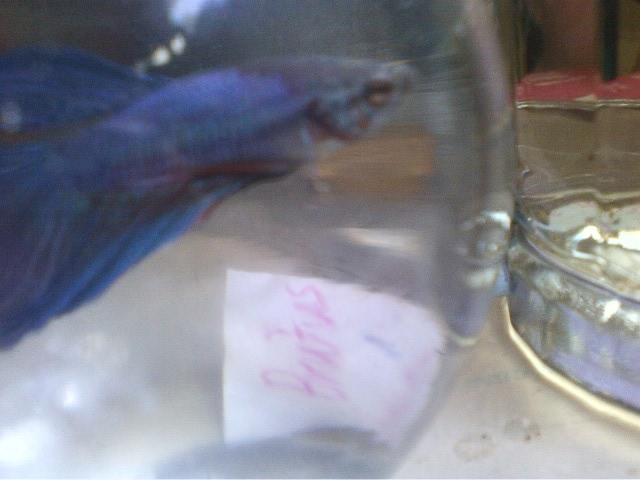 my beta has grey-ish green around his head
Question
beta closeup far off
I have had a
my beta has grey-ish green around his head
Question
beta closeup far off
I have had a
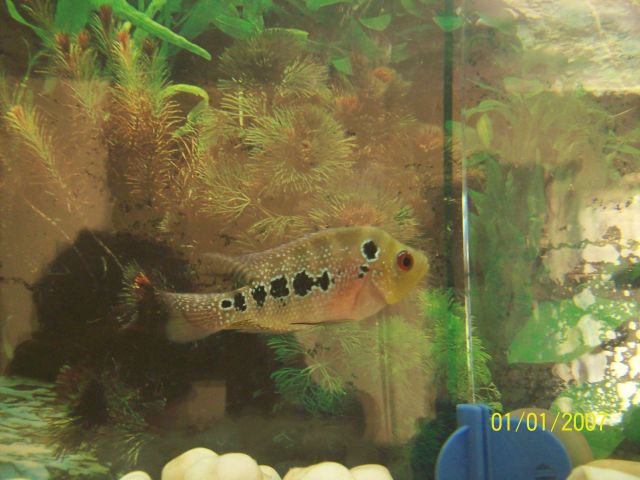 IS my flower horn male or female
Question
my flower horn
IS my flower horn male or femal
IS my flower horn male or female
Question
my flower horn
IS my flower horn male or femal
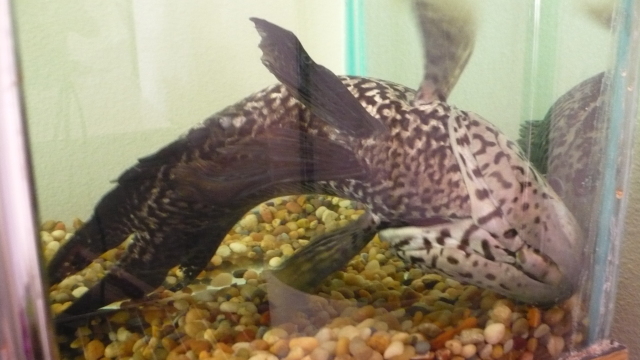 Swim Bladder Problem
Question
Buttnippers Problem
I have an 8 yr old Manguan
Swim Bladder Problem
Question
Buttnippers Problem
I have an 8 yr old Manguan
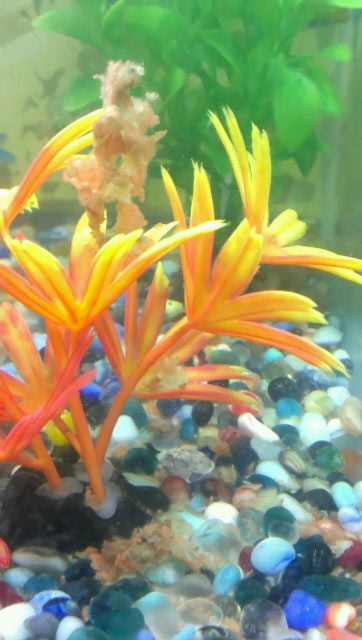 spotted molly fish pet
Question
stuff? ?? more stuff
Is it normal
spotted molly fish pet
Question
stuff? ?? more stuff
Is it normal
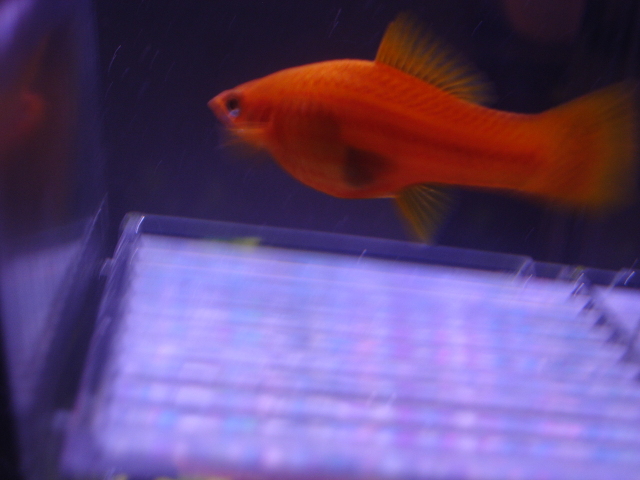 When will she give birth?
Questionpic 1
QUESTION: Hi,
I have a community
When will she give birth?
Questionpic 1
QUESTION: Hi,
I have a community